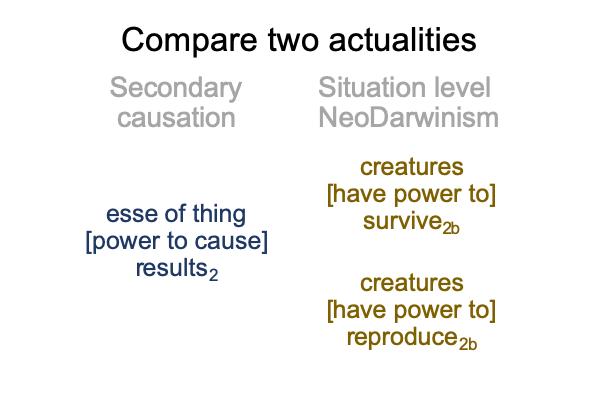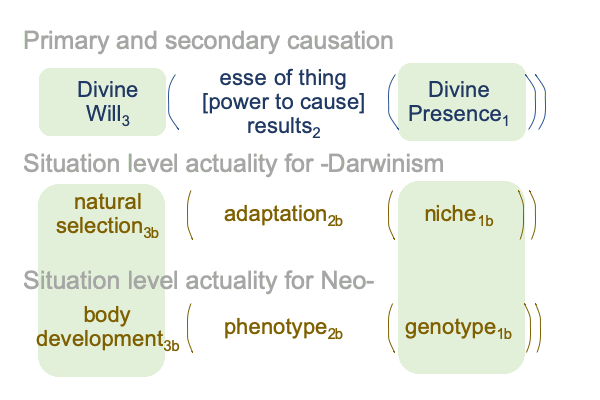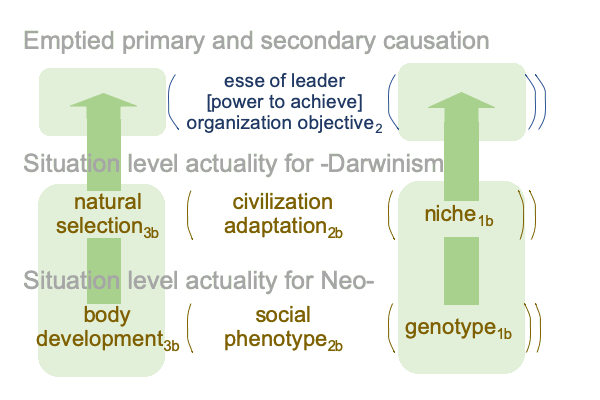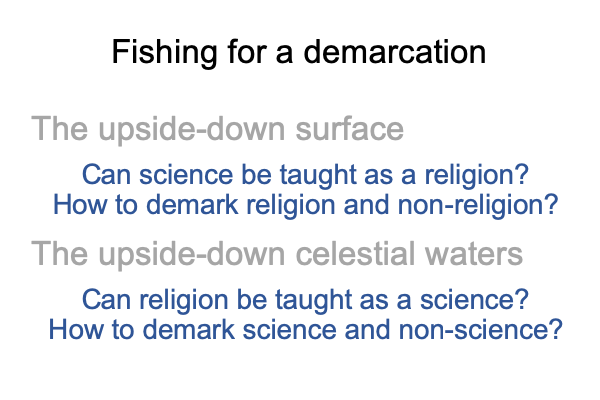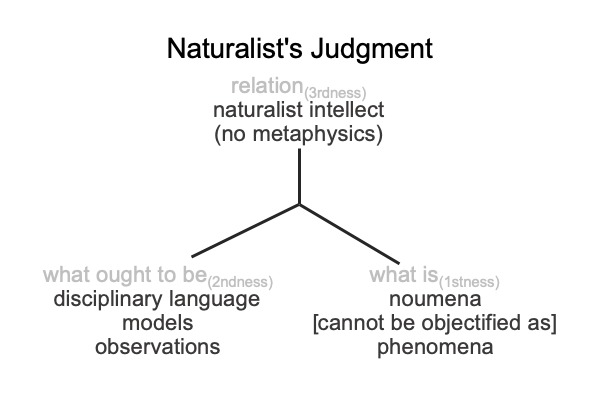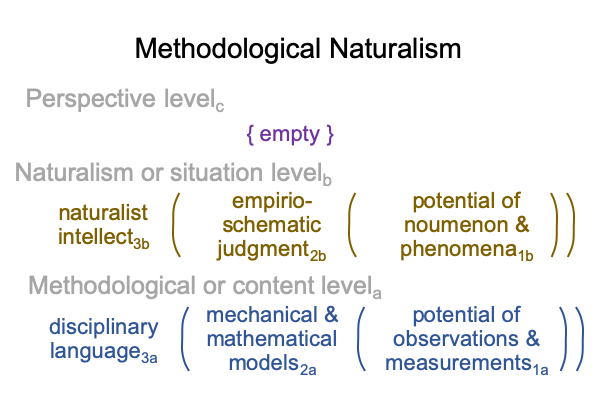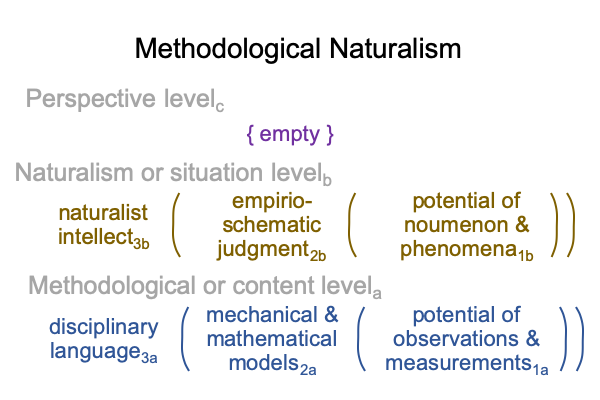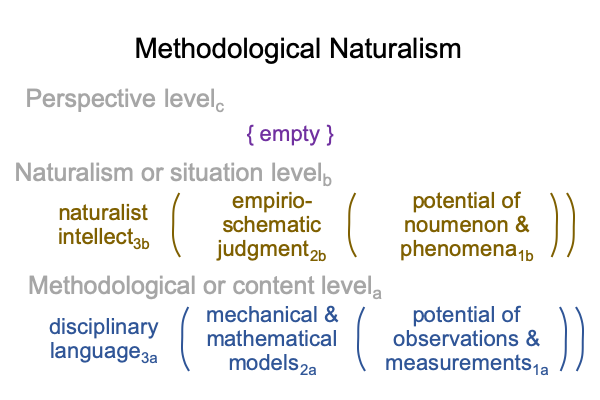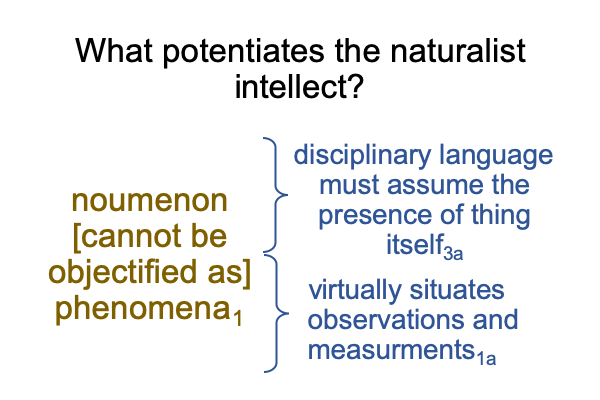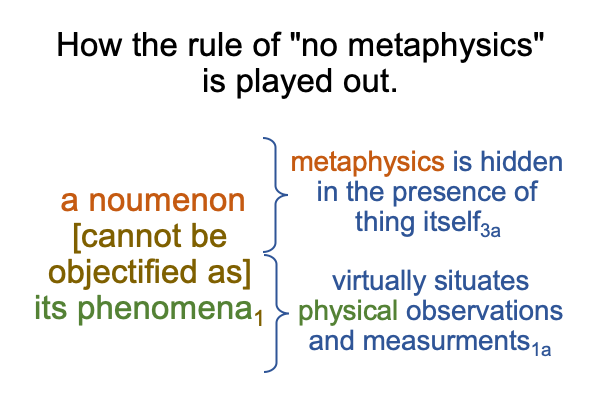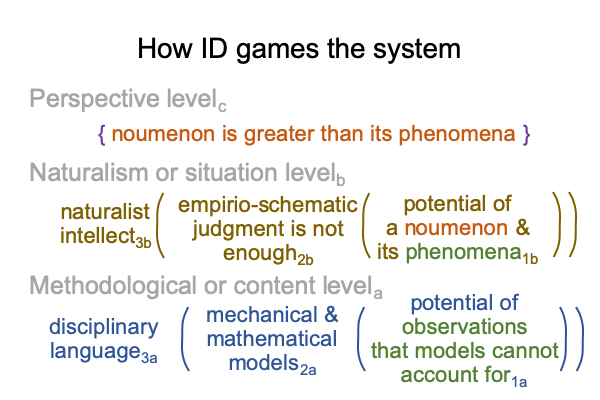Comments on Armand Maurer’s Essay (2004) “Darwin, Thomists and Secondary Causality” (Part 3)
Section One, Darwin
0027 Darwin justifies his hypothesis on the origin of species to Christians, by contemplating secondary causation. God grants adaptive powers to living creatures, allowing descent with modification.
Does God endow biological creatures with powers more subtle than instrumental and material causality?
The power to be reproductively successful means that, over time, a creature (species) can substantially change.
0028 How?
Something independent of the biological species offers an advantage to exploit or a disadvantage to avoid. This takes place in the eternal now. In each generation, those creatures that have the ability to exploit the advantage or avoid the disadvantage produce more offspring. Over the course of many generations, a species may substantially change, depending on the nature of the advantage or disadvantage.
0029 What word is under contention?
The word is “substance”. One never witnesses an adaptation so radical as to render a plant into an animal or the other way around. Plus, only one genus goes from animal to rational, implying the uniqueness of the human niche.
0030 However, if one fashions a narrower definition of substance, then one places the word in the path of descent with modification.
For example, a common ancestor ends up as two species, wolf and dog. They are substantially different, according to a consensus among biologists. Why? Each population no longer breeds with the other.
Okay, there is debate about that for wolves and dogs, but not between wolves and whales.
0031 There is more to the picture than this scientific criterion.
As species evolve, their particular substance changes over generations. Yet, at any moment in the Earth’s history, biological species appear to be stable, even during rapid ecological change. So, each species is really present only in the eternal now.
Time is required to note trends in biological evolution. So, evolution implies that species must be placed in a different normal context than everyday life. They may be compared to selective breeding of populations over time.
0032 Did Darwin grasp secondary causes in order to place a metaphorical fig leaf over his theory of natural selection?
Descent with modification implies that God (primary cause) endows creatures with powers to exploit advantages and avoid disadvantages (secondary causes) in the environment of evolutionary adaptation (EEA). Creatures do not strive to change over generations. Rather, they strive to survive and reproduce. Adaptation occurs, over many generations, as a consequence of striving in the etermal now.
0033 In order to get an idea how this looks in terms of category-based nested forms, let me conclude that there are two actualities. One actuality virtually situates the other.
Here is a diagram of actuality for a two-level interscope. See requried reading.
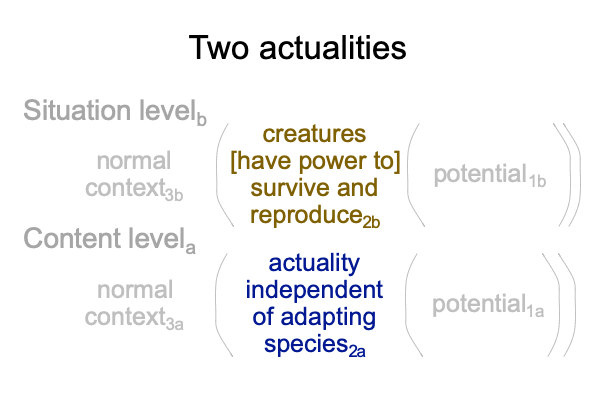
0034 In the normal context of natural selection3b, the situation-level actuality becomes adaptation2b.
In the normal context of natural selection3b, the situation-level potential becomes a niche1b.
A niche1b is a potential of an actuality independent of the adapting species2a.
As far as biologists are concerned, the content-level normal context3a and potential1a, accounting for the actuality independent of the adapting species2a may be ignored, except for one difficulty.
There is a chance that the adaptation2b will alter the actuality independent of the adapting species2a, as in the case of a beaver building a dam on a fast moving stream. The alteration produces similar results, time and time again. Reproducible results become the actuality independent of the adapting species2a. This permutation is called “niche construction”.
0035 Here is the diagram of Darwinian evolution.
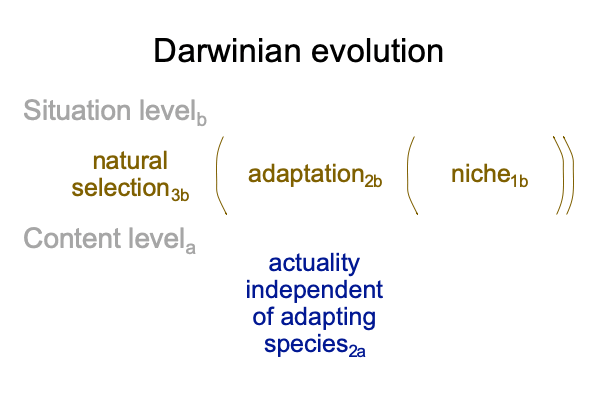
0036 So far, so good.
Where do primary and secondary causations come in?
Does the situation-level of Darwinian selection compare to the category-based nested form for primary and secondary causation?
0037 Let me start by considering the two actualities.
Adaptation2b renders as a simple actuality (without Darwin’s normal context3b and potential1b), living creature [has powers to] survive and reproduce2b.
This compares favorably to the idea that secondary causation applies to actuality2 embedded in the primary causality of a normal context3 and potential1. The actuality2 may be rendered as the dyad, the esse of the thing [has power to cause] certain results2.
0038 Here is a picture of the match.
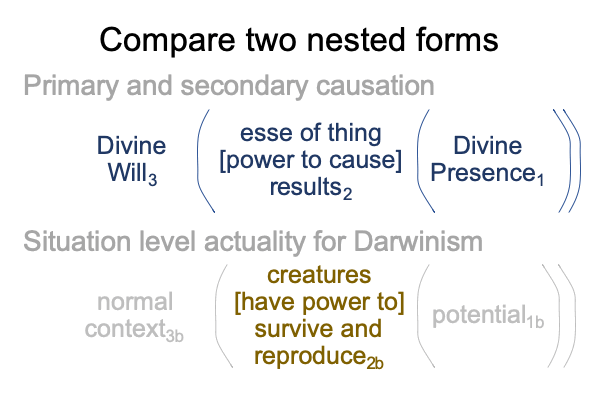
0039 Darwin hones in on secondary causes as a way to accept adaptation2b, as the esse of a living thing [has power to cause] results, including surviving and reproducing.
However, the concept of secondary causation for creatures, already promoted by Aquinas and again, by Suarez, regards the Divine Will3b and the Divine Presence1b as presiding in the eternal now, corresponding to the moment when the future becomes the past.
There a difference between “right now” and “over many generations”, just as there is a difference between “living creatures [have the power to] survive and reproduce” and “adaptation”.
0040 The creature’s power associates to the term, “substance”.
One question posed by Thomists to Darwinists, asks, “How can an adaptation, an accidental change, alter the creature’s substance, when accidents cannot add up to a substantial change?”
The answer is, “A creature’s [power] to survive and reproduce operates, over generations, in the normal context of natural selection3b and with a salient niche1b. A salient niche1b is one that offers novel opportunities and disadvantages, so that natural selection3b is not purely random. Natural selection favors certain accidents over others, leading to substantial change over generations.”
0041 So, what about the following comparison?
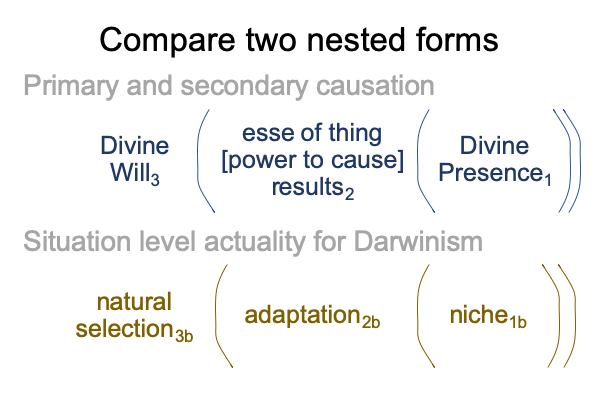
0042 The upper nested form applies to the eternal now.
The latter nested form occurs over time.
0043 Other than that, let me compare at face value.
The logic of thirdness is exclusion, alignment and complement. Any normal context3 will exclude, align with or complement another normal context3.
Thirty years before the publication of Origin of Species in 7659 U0’, Darwin entertains the idea that biological evolution may be accepted by Christians on the basis of secondary causation. If this is the case, then the Divine Will3 and natural selection3b must either align or complement.
0044 After publication, Catholic biologist, St. George Mivart (7622-7700), and American botanist, Asa Gray (7610-7688) address this if-then construct.
0045 Here, I pause and wonder.
Doesn’t the idea of secondary causes, the living creature[ has the power to] survive and reproduce, fit the pattern of declaration and development found in the six days of Creation in Genesis?
God says, “Let the earth bring forth…”, then “the earth brings forth.”
Surely, the declaration goes with normal context3 and potential1.
The development associates to actuality2.
0046 The problem?
The Spirit of the Age of the 7600s proclaims that natural selection3b excludes the Creator’s Will3. The niche1b is solely a material advantage or disadvantage offered by the environment of evolutionary adaptation2a. No Divine Presence1 is manifest. Biological evolution is godless, all the way through.
Mivart and Gray are horrified.
Both become staunch critics of Darwinism.
0047 Despite this, Mivart admits that natural selection could be one factor in biological evolution. It cannot be the only factor. After all, natural selection3b and the niche1b are external to the adaptatation2b. There must be something else, something internal, that completes the account of biological evolution.
Today, the ‘something’ that Mivart refers to is genetics. Body development3b’ completes the account that natural selection3b starts.
0048 In the normal context of body development3b, the phenotype2b emerges from (and situates) the genotype1b, where the genotype1b is the potential1b of the creature’s DNA2a.
The “Neo-“ of NeoDarwinism has precisely the same relational structure as Darwinism. Thus, a species’ internal DNA2aparallels an external actuality independent of the adapting species2a.
Here is how that looks.
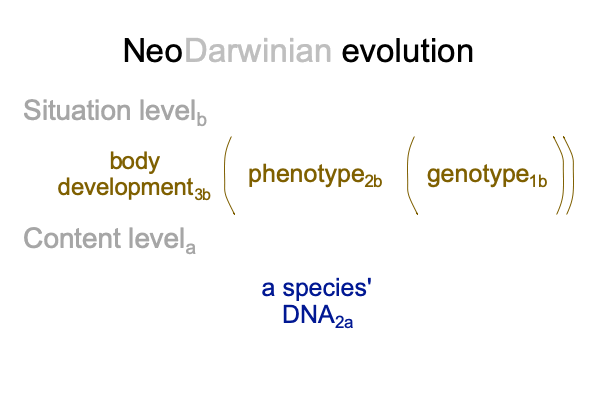
0049 I will not discuss the implications of the fact that adaptation2b and phenotype2b are independent actualities that apply to the same creature. See Comments on Dennis Venema and Scot McKnight’s Book (2017) Adam and the Genome.
Instead, I will expand the working comparison between primary and secondary causality to NeoDarwinism, as opposed to only Darwinism.
Here is the diagram.
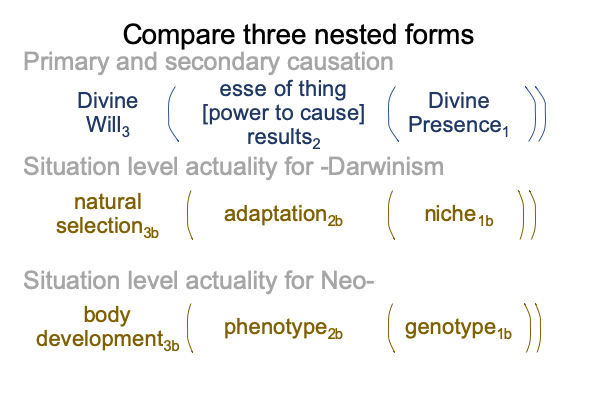
0050 After the discovery of the double-helical structure of DNA2a in the 7750s, influence-peddlers of the modern Zeitgeist work overtime insisting that both natural selection3b and body development3b exclude the Divine Will3b.
They struggle against a crucial insight. The category of firstness, the monadic realm of possibility1, operates according to the logics of inclusion. It1 allows contradictions. So, the niche1 and the genotype1 do not exclude the Divine Presence1, the potential underlying the Divine Will3.
0051 Say what?
Consider the niche1b.
The niche1b is the potential of ‘something’ outside the adapting species2a. Natural selection3b is potentiated1b by ‘something’ outside itself2a. Naturalists must insist that this potential1b arises solely from material and instrumental causes.
However, less ideologically supine biologists never keep up with the naturalist’s agenda. They routinely evoke final attributes and formal requirements and design. Birds have wings to fly. Fish have fins to swim. Final attributes and formal designs cannot be distilled down to instrumental and material causalities. They cannot be observed and measured. Instead, they are simply obvious to us.
In a way, this seems miraculous.
0052 Similarly, the genotype1b is the potential of the creature’s DNA2a. Body development3b is potentiated1b by ‘something’ inside itself2a. Naturalists must claim that this potential1b arises solely from material and instrumental causes.
But, less ideologically sensitive biologists make statements like, “Such and such gene is responsible for such and such anatomical or physiological feature.”
For example, say a new gene arises from a novel repair of the DNA2a after a strand break. How does a gamma ray select the exact location to create this fissure that is then repaired in a fashion as to produce a slightly different protein (or genotype1b)?
Talk about miracles.
0053 Of course, Darwin does not know that genetics is the mechanism of inheritance.
Suarez and Aquinas do not know that creatures evolve over geological time.
0054 Yet, here we are, on the verge of an insight.
Neither the niche1b nor the genotype1b fully exclude the Divine Presence1.
After all, the Divine Presence1 sustains the actualities of an environment of evolutionary adaptation2a and DNA2a.
How can natural selection3b and body development3b completely exclude the Divine Will3?

